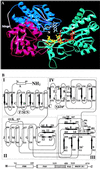Three-dimensional structure of NADPH-cytochrome P450 reductase: prototype for FMN- and FAD-containing enzymes
- PMID: 9237990
- PMCID: PMC22938
- DOI: 10.1073/pnas.94.16.8411
Three-dimensional structure of NADPH-cytochrome P450 reductase: prototype for FMN- and FAD-containing enzymes
Abstract
Microsomal NADPH-cytochrome P450 reductase (CPR) is one of only two mammalian enzymes known to contain both FAD and FMN, the other being nitric-oxide synthase. CPR is a membrane-bound protein and catalyzes electron transfer from NADPH to all known microsomal cytochromes P450. The structure of rat liver CPR, expressed in Escherichia coli and solubilized by limited trypsinolysis, has been determined by x-ray crystallography at 2.6 A resolution. The molecule is composed of four structural domains: (from the N- to C- termini) the FMN-binding domain, the connecting domain, and the FAD- and NADPH-binding domains. The FMN-binding domain is similar to the structure of flavodoxin, whereas the two C-terminal dinucleotide-binding domains are similar to those of ferredoxin-NADP+ reductase (FNR). The connecting domain, situated between the FMN-binding and FNR-like domains, is responsible for the relative orientation of the other domains, ensuring the proper alignment of the two flavins necessary for efficient electron transfer. The two flavin isoalloxazine rings are juxtaposed, with the closest distance between them being about 4 A. The bowl-shaped surface near the FMN-binding site is likely the docking site of cytochrome c and the physiological redox partners, including cytochromes P450 and b5 and heme oxygenase.
Figures






References
-
- Shen A L, Kasper C B. In: Handbook of Experimental Pharmacology. Schenkman J B, Greim H, editors. New York: Springer; 1993. pp. 35–59.
-
- Strobel H W, Hodgson A V, Shen S. In: Cytochrome P450: Structure, Mechanism, and Biochemistry. Ortiz de Montellano P R, editor. New York: Plenum; 1995. pp. 225–244.
-
- Williams C H, Kamin H. J Biol Chem. 1962;237:587–595. - PubMed
-
- Phillips A H, Langdon R G. J Biol Chem. 1962;237:2652–2660. - PubMed
-
- Schacter B A, Nelson E B, Marver H S, Masters B S S. J Biol Chem. 1972;247:3601–3607. - PubMed
Publication types
MeSH terms
Substances
Grants and funding
LinkOut - more resources
Full Text Sources
Other Literature Sources
Molecular Biology Databases

